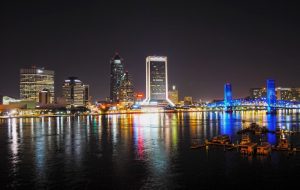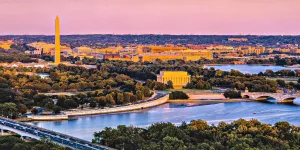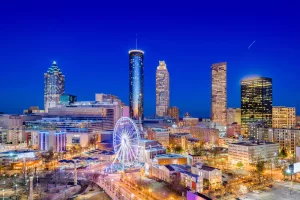Most Dangerous Neighborhoods in Jacksonville
Go Back To Previous PageIs Jacksonville Safe?
Jacksonville’s crime rate is higher than the national average, with 64 crimes per 1,000 residents, 44% above the national average.
However, specific areas concentrate most crimes. By staying informed about which neighborhoods to avoid, you can still have a safe and enjoyable visit to Jacksonville.
Most Dangerous Neighborhoods in Jacksonville, FL
1. East Jacksonville: the most Dangerous Neighborhood in Jacksonville
East Jacksonville is considered the most dangerous area in Jacksonville, Florida. Its convenient location near downtown gives residents easy access to vibrant events that keep the community lively.
that keep the community lively.
However, beneath the hustle and bustle lies a troubling reality: violent crime rates and aggravated assaults here are 88% higher than the national average. With a population of nearly 3,000, the numbers show a worrying trend.
People in East Jacksonville have a 1 in 23 chance of being a crime victim.
2. Hogan’s Creek
Hogan’s Creek is another area in Jacksonville that should be avoided. Nearly 2,000 residents live in Hogan’s Creek; however, beneath its natural beauty lies a troubled history.
The area has been plagued by years of pollution, failing infrastructure, and development challenges. Despite various revitalization efforts, crime rates remain persistently high, matching the levels found in East Jacksonville, which are 88% above the national average.
For those living here, the likelihood of becoming a victim of crime is 1 in 23.
3. College Gardens
College Gardens is considered one of the worst neighborhoods in Jacksonville.
Despite being famous for its schools, safety issues are a significant concern. Crime rates in this area are 84% higher than the national average. With a population of about 2,300, residents face the unsettling reality of a 1 in 23 chance of experiencing crime in their community.
4. Fairfield
Fairfield’s landscape reflects a mix of heavy industry and recreational spaces, highlighting its enduring resilience. Despite its industrial past, the area has pockets of housing, showcasing residential life. However, property crime rates remain 82% above the national average.
Fairfield has just over 1,000 residents, so people here have a 1 in 23 chance of experiencing crime.
5. Lackawanna
People consider Lackawanna, a historic streetcar suburb on Jacksonville’s Westside, as one of the most dangerous neighborhoods in the city because of its high crime rate. Despite its historic charm, the area faces a troubling reality, with crime rates soaring 87% higher than the national average.
With a population similar to that of Fairfield, residents here encounter a slightly lower, yet still significant, risk of becoming a victim of crime, with a 1 in 24 chance according to data collected by the police department.
6. 45th and Moncrief
In the heart of the 45th and Moncrief area lies a community of over 3,000 residents, where the struggles of daily life often intersect with the streets. Crime rates in this neighborhood are 85% higher than the national average, creating a shadow over everyday activities.
With a population exceeding 3,000, individuals in 45th and Moncrief face a 1 in 24 chance of experiencing crime. Although the area is affordable, safety remains a significant concern, compounded by an unemployment rate soaring to 12%.
7. Moncrief Park
Moncrief Park, located within its namesake park, is home to a community of over 2,700 residents. However, the area’s peacefulness contrasts sharply with its alarming crime statistics. Crime rates here are 83% higher than the national average, creating a troubling picture of safety.
For residents, the likelihood of becoming a victim of crime is 1 in 24.
8. Allendale
Allendale is a neighborhood where heavy industry coexists with residential life, creating a constant hum of productivity. However, alongside this vibrancy, safety concerns are significant. Crime rates in the area are 83% higher than the national average, which casts a shadow over its 2,100 residents.
Despite its historical importance as an early airfield site, safety remains a pressing issue for those who call Allendale home.
9. Mid-Westside
Mid-Westside, home to a vibrant population of nearly 8,800, is a bustling hub of activity. However, beneath its lively exterior lies a concerning reality: crime rates in the area are 83% higher than the national average, similar to those of neighboring Allendale.
Vandalism and broken windows are familiar sights, underscoring residents’ safety challenges. In Mid-Westside, the likelihood of encountering crime is 1 in 24.
10. 29th and Chase
At the intersection of 29th and Chase, life unfolds amid economic hardships and safety concerns. Crime rates in this area are 80% higher than the national average, presenting a harsh reality for its 1,600 residents.
With a per capita income significantly lower than the Jacksonville average, residents often face financial struggles and safety worries. In this community, the odds of becoming a victim of crime are 1 in 24.
11. Lake Forest
Lake Forest is another neighborhood in Jacksonville that is facing safety concerns. Although development has brought progress, it has also led to challenges, with crime rates soaring 60% higher than the national average.
Despite the tranquil surroundings, residents in Lake Forest have a 1 in 27 chance of experiencing crime firsthand.
12. Murray Hill
Once a quiet neighborhood, Murray Hill has undergone a vibrant transformation driven by local art and craft beer. Today, it is one of Jacksonville’s trendiest spots, attracting young entrepreneurs eager to make their mark.
However, crime rates in the area are 44% higher than the national average, reminding us of the realities beneath the hipfaçadee. Despite its appeal, the odfaçadeencountering crime in Murray Hill are 1 in 30.
13. Springfield
Springfield, rich in history and charm, has roots that date back to 1869. Once a haven for the city’s elite and silent film stars, it now features a diverse community living in wooden residential buildings.
Although crime rates are 43% higher than the national average, the neighborhood’s appeal remains strong.
For residents of Springfield, the likelihood of becoming a victim of crime is 1 in 31, highlighting the complexities beneath the city’s historic façade.


